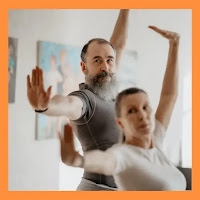Yes you have ‘January Good Intentions’ to do more exercise! But how do you put this into the overall context of keeping your biological age well below your actual years?
Well the simple answer is ‘just get moving’ but it needs to be well thought out to get the maximum benefit for the time and effort involved. Here are 5 things to think about.
1. Prioritise consistency and being energetic
The trouble with exercise is that it has to be a regular thing to be beneficial. So first, be consistent - move in some way, every day of the week. Moving can be anything you like eg walking, swimming, cycling, roller skating, dancing, playing tennis, doing a yoga sequence or a quick body weight workout just to name a few options.
Second, move energetically. Even a 10 minute brisk walk has significant impact, IF it is both a daily thing and you do it at pace – it cannot be an idle stroll. If you are doing a regular route, then try to extend the distance within the time frame. So walking out for 5 minutes and back for 5 minutes on the same route means you can gradually extend how far you get to after 5 minutes by speeding up and by lengthening your stride. You should be a little hot and out of breath.. If you can, get a buddy to do this with. They will keep you to it and vice versa. Variety helps motivation, too!
Once this habit is established, Ideally you progress to including something more demanding and in the 30-40 minute range 2- 3 times a week instead of your walk.
2. The golden triangle: strength, flexibility and balance
Let’s be clear what we need to achieve. The adverse changes of a sedentary life and increasing years are loss of strength, loss of flexibility in the spine and around all joints and reduced neuromuscular coordination and balance. If you spend 30 minutes walking or running on a treadmill at the gym, then this IS exercise but a more targeted use of your time focusing on the golden 3 will be of more benefit in preventing falls and maintaining all critical functions. Nor do we want to do ‘body building type exercise that focuses on single muscles eg building up your biceps. The ideal is a more complex movement that uses multiple muscle groups and your core all at the same time so you build up strength in all your muscles.
For flexibility, a yoga class and some daily yoga stretches is ideal. Some Pilates classes include yoga elements and this can be a good combined routine. Any sport or dance activity will build coordination and balance.
If your goals include weight loss then your expectations should be realistic. It is not the exercise that causes the weight loss, unless you are training at the sort of intensity needed to prepare for a marathon or triathlon. So golden triangle based activity will tone up your body, speed up your metabolism and give you motivation but you will need a new way of eating, too.
3. Get help to get it right
If you have experience of ‘training’ then you know what to do. If you don’t, then join a class, follow a program like ‘Couch to 5 K’ or get a trainer to recommend a program for you targeted on the 3 golden elements, above.
Good support will make sure you are challenging yourself within your capacity, and what you do is safe, structured and balanced and you don’t injure yourself. If walking is your preferred exercise, then include some hills and consider Nordic Walking using poles to get a much more useful workout. There is lots on You Tube about how to get started with this and there may be a walking group in your area. If you want to run, the advice is get strong and fit to enable you to run not run to get strong and fit. These elements are included in programs like Couch to 5K.
4. Progress incrementally
As you get into the swing of regular exercise you need to increase the difficulty and/or intensity of what you do. Otherwise you will ‘plateau’ and gains will cease. The intensity is more important than the time spent. So interval training is better than constant speed work. Walking as fast as you can until you get short of breath, eg 2 minutes then walking more slowly for say 1 minute until you have your breath back and repeating this 5 times is better than walking slowly for an hour. You can progress this by walking up an incline and recovering by walking back down.
5. Think Microbiome!
Finally, recent research shows a connection between the bacteria in your colon and motivation to exercise. Another benefit from having the right mix of pro and prebiotics in your diet.
“Our findings indicate that the rewarding properties of exercise are influenced by gut-derived brain stimulating chemicals and provide a microbiome-dependent explanation for interindividual variability in exercise performance and that the transmission of gut-derived signals to the brain may enhance the motivation for exercise.”*
I have written about how to influence your microbiome here. If you have weight loss plans then managing your microbiome is an essential component.


No comments:
Post a Comment